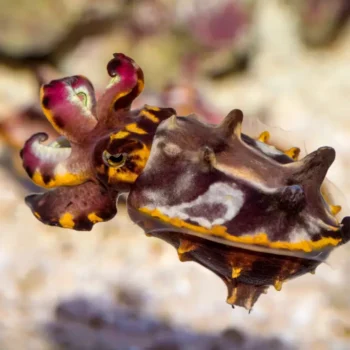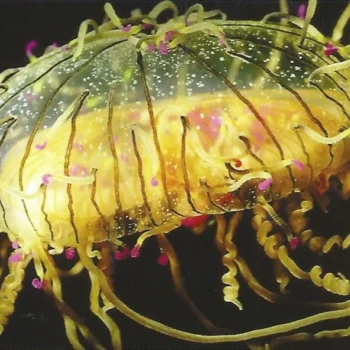Have you ever wondered what lurks in the deepest, darkest parts of the ocean? Meet the Fangtooth Fish (Anoplogaster cornuta), a fascinating creature perfectly adapted to survive in extreme conditions. Let’s dive in and explore everything about this remarkable deep-sea predator!
What is a Fangtooth Fish?
The Fangtooth Fish belongs to the family Anoplogastridae. While they might look intimidating, these fish are relatively small. Two species exist, the common fangtooth (Anoplogaster cornuta), and the rarer shorthorn fangtooth (Anoplogaster brachycera). We’ll primarily focus on the common fangtooth in this article.
Scientific Classification
- Kingdom: Animalia
- Phylum: Chordata
- Class: Actinopterygii
- Order: Stephanoberyciformes
- Family: Anoplogastridae
- Genus: Anoplogaster
- Species: Anoplogaster cornuta
Appearance and Characteristics
The Fangtooth Fish gets its name from its exceptionally large, dagger-like teeth. In fact, their teeth are so big that they can’t even fully close their mouths! Let’s break down some of their key features:
Key Features
- Teeth: These are the Fangtooth’s most defining feature. Their lower teeth are so long that they fit into sockets on either side of their brain when their mouth is closed.
- Size: Adult Fangtooth Fish typically reach a length of about 6 inches (17 centimeters).
- Coloration: They are usually dark brown or black, which helps them blend in with the darkness of the deep sea.
- Body Shape: Their bodies are relatively short and deep, with a large head.
- Eyes: They have small eyes relative to their body size, an adaptation to the low-light conditions of their environment.
Habitat and Distribution
Fangtooth Fish are found in deep waters around the world. They are typically found in the Atlantic, Pacific, and Indian Oceans. They prefer depths ranging from 650 to over 6,500 feet (200 to 2,000 meters).
Deep-Sea Life
Living at these depths means facing extreme pressure, cold temperatures, and a lack of sunlight. The Fangtooth Fish is well-adapted to thrive in this environment.
 Flamboyant Cuttlefish Guide: Unveiling Metasepia pfefferi’s Amazing Colors & Behaviors
Flamboyant Cuttlefish Guide: Unveiling Metasepia pfefferi’s Amazing Colors & BehaviorsDiet and Feeding Habits
The Fangtooth Fish is a voracious predator. They are not picky eaters and will consume almost anything they can find. Their diet mainly consists of smaller fish, crustaceans, and other invertebrates. They use their large teeth to capture and hold onto prey.
Hunting Strategies
- They are believed to be ambush predators, waiting patiently in the dark for prey to come within striking distance.
- Their sensitive lateral line helps them detect vibrations in the water, allowing them to sense the presence of prey even in complete darkness.
Adaptations to the Deep Sea
The Fangtooth Fish possesses several adaptations that allow it to survive in the harsh environment of the deep sea.
Key Adaptations
- Bioluminescence: While not bioluminescent themselves, they can likely detect the faint glows of other deep-sea creatures, helping them find prey.
- Low Metabolism: They have a slow metabolism, which helps them conserve energy in an environment where food can be scarce.
- Pressure Resistance: Their bodies are adapted to withstand the immense pressure of the deep sea.
- Large Mouth and Teeth: These features allow them to capture and consume a wide range of prey items.
Reproduction and Life Cycle
Much of the Fangtooth Fish’s reproductive behavior is still a mystery to scientists. However, we know some general details.
What We Know
- They are believed to spawn in open water.
- Their larvae are significantly different in appearance from the adults, having spines on their heads and bodies.
- As they mature, they undergo a significant metamorphosis, losing their spines and developing their characteristic teeth.
Conservation Status
The Fangtooth Fish is currently listed as Least Concern by the International Union for Conservation of Nature (IUCN). This means that they are not currently considered to be threatened or endangered.
Threats
However, it’s important to remember that the deep sea is a fragile environment, and potential threats to the Fangtooth Fish include:
 The Fascinating Flower Hat Jellyfish: A Comprehensive Guide
The Fascinating Flower Hat Jellyfish: A Comprehensive Guide- Deep-sea trawling: This fishing method can damage their habitat and incidentally catch them.
- Pollution: The accumulation of pollutants in the deep sea can affect their health and reproductive success.
- Climate Change: Changes in ocean temperature and chemistry could potentially impact their habitat and food sources.
Conclusion
The Fangtooth Fish (Anoplogaster cornuta) is a remarkable example of adaptation to extreme environments. This small but fierce predator plays an important role in the deep-sea ecosystem. While they are not currently threatened, it is crucial to protect their habitat and monitor their populations to ensure their continued survival in the face of increasing pressures on the deep ocean.




